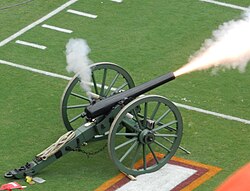| "Skipper" | |
|---|---|
 "Skipper" is fired at every home football game, during pre-game ceremonies (photo) and after every score. | |
| Type | Virginia Tech game cannon |
| Place of origin | United States |
| Service history | |
| In service | Skipper:1963-1982; Skipper II:1984-present |
| Used by | Virginia Tech Corps of Cadets |
| Wars | Autumn Weekends, Commonwealth Clash |
| Production history | |
| Designer | Homer Hickam |
| Designed | 1963 (c1860 Civil War replica) |
| Manufacturer | Virginia Foundry Co.; Lorton Reformatory |
| Produced | Skipper:1963; Skipper II:1984 |
| No. built | 2 |
| Variants | marking: 'VTCC 1964 - 65 - 66 - 67' |
| Specifications | |
| Mass | 1000 lbs (Skipper II: 800 lbs) |
| Length | Skipper II: 70 in. |
| Width | n/a |
| Height | n/a |
| Diameter | 6" (Skipper II: 3") |
| Crew | "Skipper Crew" - (10 cadet team) |
"Skipper" is the name of the Virginia Tech Corps of Cadets' cannon that is sounded at home football games and other events. [1] The game cannon was created by a group of cadets in 1963 for Virginia Tech football games and special events. [2] [3]
Contents
- Background
- Corps of Cadets
- Thanksgiving Day rivalry game
- Making Skipper
- Planning and funding
- Design, Construction and Naming
- Testing and Firing Skipper
- Testing and Salute to JFK
- The 1963 Thanksgiving Day game
- 1982 blowout and retirement
- Replacing Skipper
- Skipper II
- Skipper's Legacy
- Skipper Crew
- Caldwell March
- Milestones
- Publications
- References
- External links





